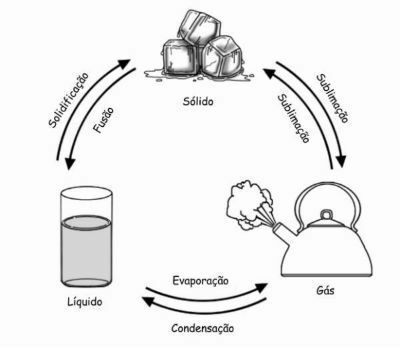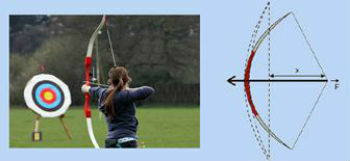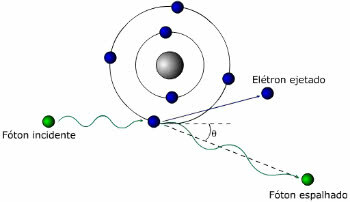Waves are disturbances that propagate through space without transporting matter, only energy.
The element that causes a wave is called a source, for example, a stone thrown into the waters of a river will generate circular waves.
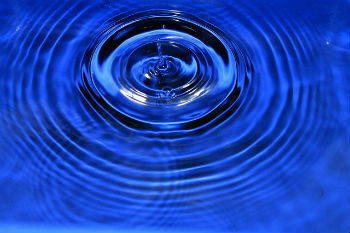
Circular waves on the surface of a liquid
Examples of waves are: sea waves, radio waves, sound, light, x-ray, microwave among others.
The part of physics that studies waves and their characteristics is called wave.
Wave Characteristics
To characterize the waves we use the following quantities:
- Amplitude: corresponds to the height of the wave, marked by the distance between the equilibrium (resting) point of the wave and the crest. Note that the “crest” indicates the maximum point of the wave, while the “valley” represents the minimum point.
- Wave-length: Represented by the Greek letter lambda (λ), it is the distance between two successive valleys or crests.
- Speed: represented by the letter (v), the speed of a wave depends on the medium in which it is propagating. So when a wave changes its propagation medium, its speed can change.
- Frequency: represented by the letter (f), in the international system the frequency is measured in hertz (Hz) and corresponds to the number of wave oscillations in a given time interval. The frequency of a wave does not depend on the propagation medium, only on the frequency of the source that produced the wave.
- Time course: represented by the letter (T), the period corresponds to the time of a wavelength. In the international system, the period measurement unit is seconds (s).

Types of waves
As for the nature, there are two types of waves:
- Mechanical waves: for propagation to occur, mechanical waves need a material medium, for example, sound waves and waves on a string.
- Electromagnetic waves: in this case, it is not necessary that there is a material medium for the wave to propagate, for example, radio waves and light.
Wave Classification
According to wave propagation direction, they are classified into:
-
One-dimensional waves: waves that propagate in one direction.
Example: waves on a rope. -
two-dimensional waves: waves that propagate in two directions.
Example: waves propagating on the surface of a lake. -
three-dimensional waves: waves that propagate in all possible directions.
Example: sound waves.
Waves can also be classified according to the vibration direction:
-
Longitudinal Waves: source vibration is parallel to wave displacement.
Example: sound waves
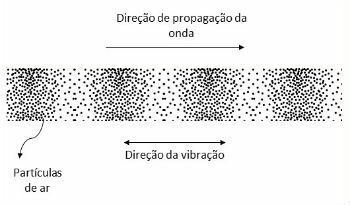
-
Transverse Waves: the vibration is perpendicular to the wave propagation.
Example: wave on a string.
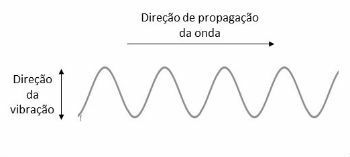
Formulas
Relationship between period and frequency
Period is the inverse of frequency.
Thus:

propagation speed

Velocity can also be calculated as a function of frequency, substituting period for the inverse of frequency.
We have:

Example
What is the period and propagation speed of a wave that has a frequency of 5Hz and a wavelength of 0.2 m?
As the period is the inverse of the frequency, then:

To calculate the velocity we use the wavelength and frequency, like this:

Undulating Phenomena
Reflection
A wave propagating in a certain medium when encountering an obstacle can suffer reflection, that is, to reverse the propagation direction.
Upon reflection, the wavelength, propagation speed and frequency of the wave do not change.
An example is when a person shouts in a valley and hears a few seconds later the echo of his voice.
Through light reflection we can see our own image on a polished surface.

Image reflected in the calm surface of a lake
Refraction
Refraction is a phenomenon that happens when a wave changes the propagation medium. In this case, a change in velocity value and propagation direction may occur.
Waves on a beach break parallel to the shore, due to the phenomenon of refraction. The change in water depth (propagation medium) causes the direction of the waves to change, making them parallel to the shore.
Diffraction
The waves go around obstacles. When this happens we say that the wave has been diffracted.
Diffraction allows us to hear, for example, a person on the other side of a wall.
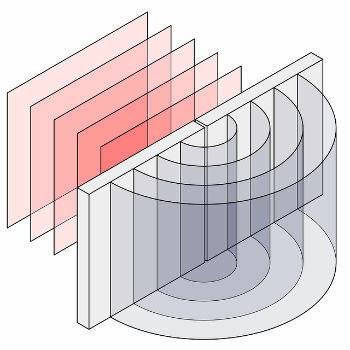
When passing through an obstacle, the waves are scattered.
Interference
When two waves meet, an interaction occurs between their amplitudes called interference.
Interference can be constructive (increased amplitude) or destructive (decreased amplitude).
standing waves
Standing waves occur from the superposition of equal periodic waves and from opposite directions.
When constructive and destructive interference occurs, they present points that vibrate and others that do not vibrate.
We can produce standing waves on a string with fixed ends, for example, on the strings of a guitar.
Know all about:
- Sound waves
- Speed of sound
- Speed of light
- Energy
- gravitational waves
- Physics Formulas
Entrance Exam Exercises
1. (ENEM - 2016)
The electrocardiogram, a test used to assess the state of a patient's heart, is a record of the electrical activity of the heart over a certain period of time. The figure represents the electrocardiogram of a rested, non-smoking adult patient in a pleasant temperature environment. Under these conditions, a heart rate between 60 and 100 beats per minute is considered normal.
Based on the electrocardiogram presented, it is identified that the patient's heart rate is
not normal.
b) above the ideal value
c) below the ideal value
d) close to the lower limit
e) close to the upper limit
Alternative c) below the ideal value
2. (ENEM 2013)
When traveling by plane, passengers are requested to turn off all devices whose operation involves the emission or reception of electromagnetic waves. The procedure is used to eliminate radiation sources that could interfere with the pilots' radio communications with the control tower.
The property of the emitted waves that justifies the adopted procedure is the fact that
a) have opposite phases
b) be both audible
c) have inverse intensities
d) be of the same range
e) have close frequencies
Alternative e) have close frequencies
3. (ENEM 2013)
A common manifestation of fans in football stadiums is the Mexican ola. The spectators of a line, without leaving their place and without moving laterally, stand and sit, synchronized with those of the adjacent line. The collective effect spreads through the stadium spectators, forming a progressive wave, as shown in the illustration.
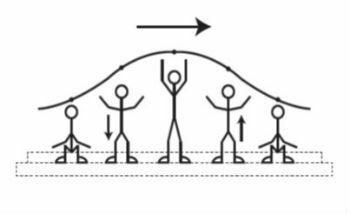
It is estimated that the propagation speed of this “human wave” is 45 km/h, and that each period of oscillation contains 16 people, who stand up and sit neatly and spaced 80 cm apart from each other.
In this Mexican ola, the wave frequency, in hertz, is a value closer to
a) 0.3
b) 0.5
c) 1.0
d) 1.9
e) 3.7
Alternative c) 1.0

